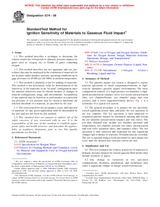Wir benötigen Ihre Einwilligung zur Verwendung der einzelnen Daten, damit Sie unter anderem Informationen zu Ihren Interessen einsehen können. Klicken Sie auf "OK", um Ihre Zustimmung zu erteilen.
ASTM G74-08
Standard Test Method for Ignition Sensitivity of Materials to Gaseous Fluid Impact
Automatische name übersetzung:
Standard Test Method for Ignition Empfindlichkeit der Materialien zu gasförmigen Fluid Schlag
NORM herausgegeben am 1.9.2008
Informationen über die Norm:
Bezeichnung normen: ASTM G74-08
Anmerkung: UNGÜLTIG
Ausgabedatum normen: 1.9.2008
SKU: NS-57805
Zahl der Seiten: 7
Gewicht ca.: 21 g (0.05 Pfund)
Land: Amerikanische technische Norm
Kategorie: Technische Normen ASTM
Die Annotation des Normtextes ASTM G74-08 :
Keywords:
gaseous fluid impact, ignition sensitivity, oxygen enriched environment, Air analysis, Gases, High-velocity gaseous impact testing, Ignition--rubber/cellular materials, Ignition sensitivity, Impact testing, Liquids--laboratory applications, Lubricating grease, O-rings, Oxygen material compatibility, Pressure testing--leaks, Semi-solid materials, Sensitivity criterion/response, Sheet materials (general), Solid phase materials, Stainless steel, Velocity, Visual examination
Ergänzende Informationen
| Significance and Use | ||||||||||||||||||||||||||||||||||||||||||||||||||||||
|
This test evaluates the relative sensitivity of materials to dynamic pressure impacts by various gaseous fluid media (may include mixtures of gases). Any change or variations in test specimen configurations, thickness, preparation, and cleanliness may cause a significant change in impact sensitivity/reaction. A reaction is indicated by an abrupt increase in test specimen temperature or by obvious changes in odor, color, or material appearance, or a combination thereof, as observed during post test examinations. Odor alone is not considered positive evidence that a reaction has occurred. Suggested criteria for test completion at a given pressure are: Each specimen is subjected to five impacts. A material passes if no reactions occur in 20 successive samples. A material fails if one reaction occurs in a maximum of 20 or fewer successive samples. Materials may be ranked by the maximum pressure (pressure threshold) at which they pass the test. Material acceptance may be on the basis of passing at a selected pressure. |
||||||||||||||||||||||||||||||||||||||||||||||||||||||
| 1. Scope | ||||||||||||||||||||||||||||||||||||||||||||||||||||||
|
1.1 This method describes a technique to determine the relative sensitivity of materials to dynamic pressure impacts by gases such as oxygen, air, or blends of gases containing oxygen. 1.2 This method describes the test apparatus and test procedures that may be employed in the evaluation of materials for use in gases under dynamic pressure operating conditions up to gage pressures of 10 000 psi (69 MPa) at ambient temperature. 1.3 This method is primarily a test for ranking of materials. This method is not necessarily valid for determination of the sensitivity of the materials in an “as-used” configuration since the material sensitivity may be altered because of changes in material configuration, usage, and environment. Acceptability of any material may be based on its performance at a particular test pressure, or test pressure may be varied to determine the reaction threshold of a material, as specified by the user. 1.4 The criteria used for the acceptance, retest, and rejection of materials for any given application shall be determined by the user and are not fixed by this method. 1.5 This standard does not purport to address all of the safety concerns, if any, associated with its use. It is the responsibility of the user of this standard to establish appropriate safety and health practices and determine the applicability of regulatory limitations prior to use. For specific precautions see Section 7. |
||||||||||||||||||||||||||||||||||||||||||||||||||||||
| 2. Referenced Documents | ||||||||||||||||||||||||||||||||||||||||||||||||||||||
|
Empfehlungen:
Aktualisierung der technischen Normen
Wollen Sie sich sicher sein, dass Sie nur die gültigen technischen Normen verwenden?
Wir bieten Ihnen eine Lösung, die Ihnen eine Monatsübersicht über die Aktualität der von Ihnen angewandten Normen sicher stellt.
Brauchen Sie mehr Informationen? Sehen Sie sich diese Seite an.




 Cookies
Cookies
